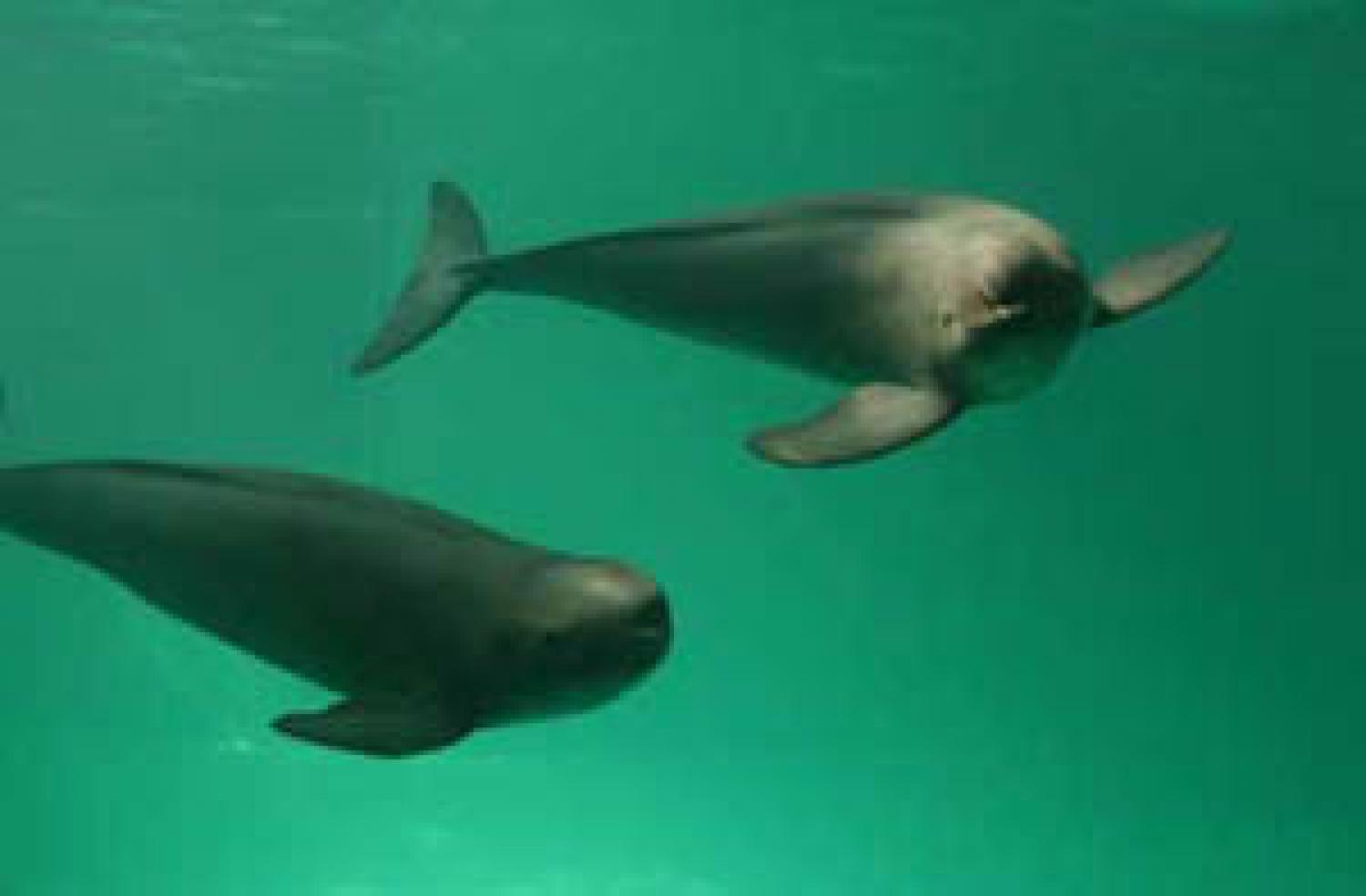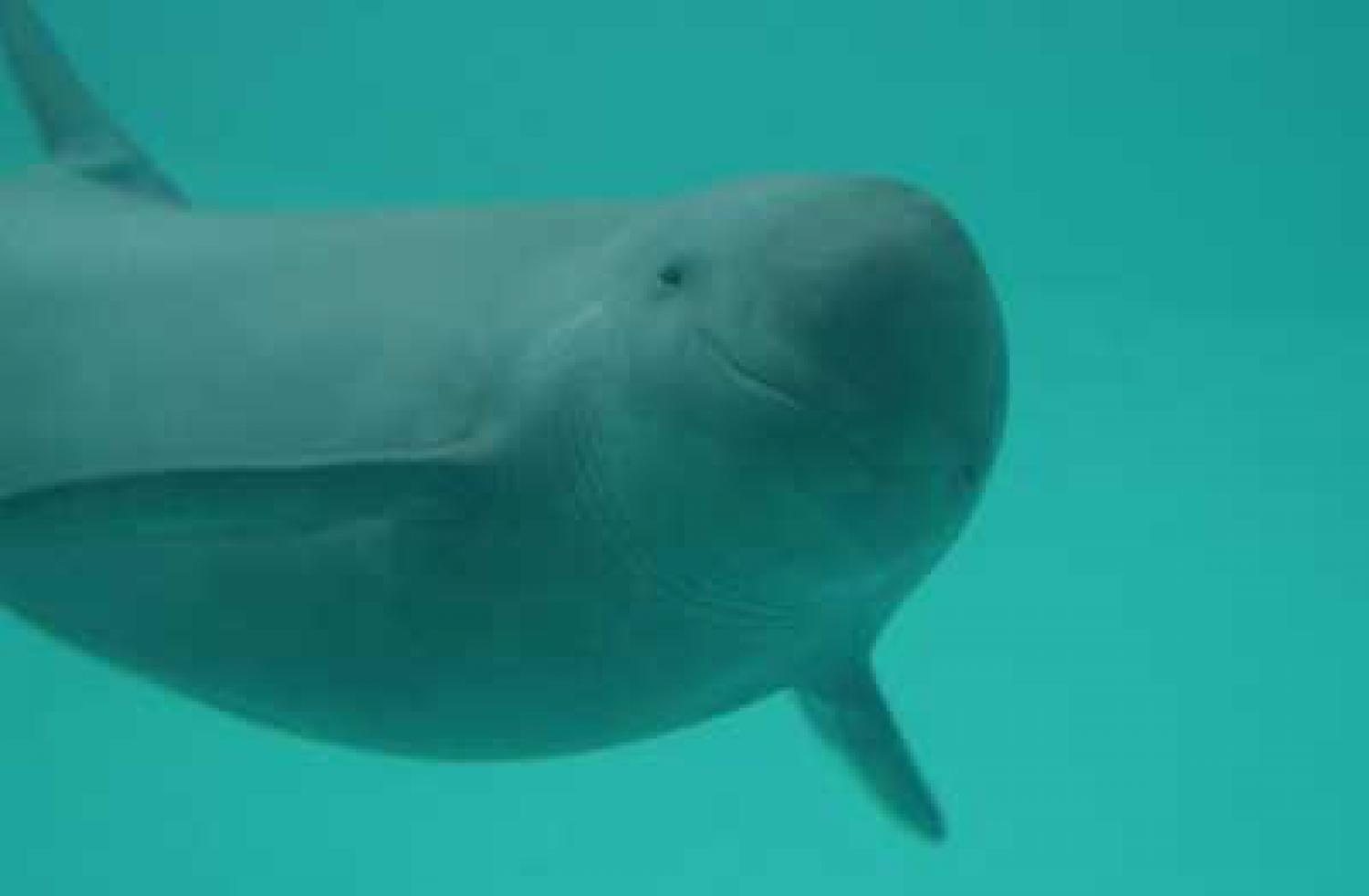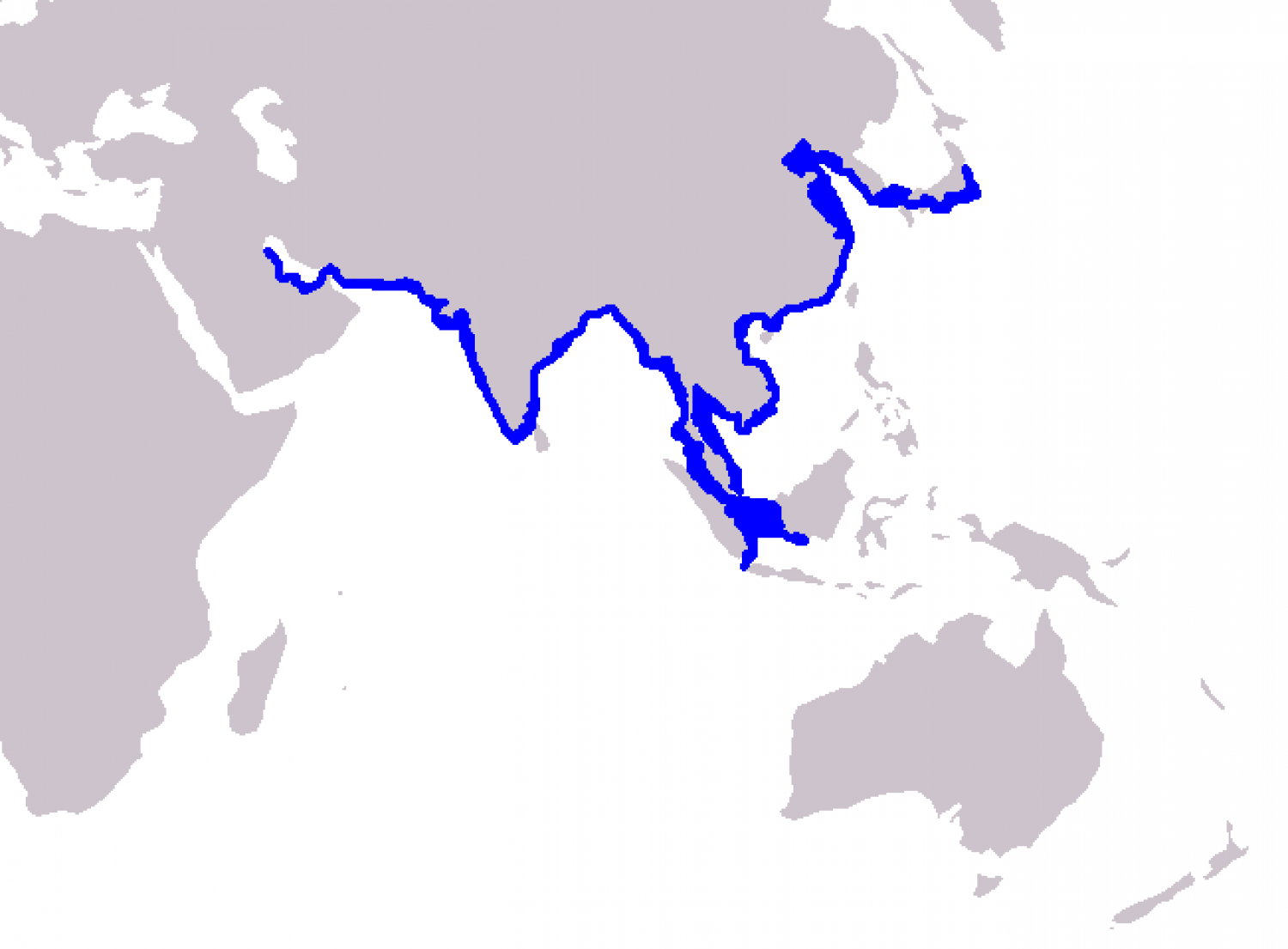Species of Thailand
Finless porpoise
Neophocaena phocaenoides
Georges-Frédéric Cuvier, 1829
The finless porpoise () is one of six porpoise species. Most of the population has been found around the Korean peninsula in the Yellow and East China Seas, although a freshwater population is found around Jiuduansha near Shanghai at the mouth of China's Yangtze River. Genetic studies indicate that the finless porpoise is the most basal living member of the porpoise family.
There is a degree of taxonomic uncertainty surrounding the species, with the N. p. phocaenoides subspecies perhaps representing a different species from N. p. sunameri and N. p. asiaeorientalis.
Name
The Korean communities of the porpoise are sometimes known as sanggwaengi (); the Chinese, particularly the subspecies N. p. asiaorientalis, as jiangtun (, p jiāngtún, "river suckling"); and the Japanese, particularly the subspecies N. p. sunameri, as sunameri ().
Distribution
The finless porpoise lives in the coastal waters of Asia, especially around Japan, Korea, China, Indonesia, India, and Bangladesh. Throughout their range, the porpoises stay in shallow waters, up to 50 m deep, close to the shore, in waters with soft or sandy seabeds, or in estuaries and mangrove swamps. In exceptional cases, they have been encountered as far as 135 km off-shore in the East China and Yellow Seas, albeit still in shallow water.
There are three recognised subspecies.
A genetically unique freshwater population (N. p. asiaeorientalis) is found in the Yangtze River. At the western end, their range includes the length of the western coast of India and continues up into the Persian Gulf. N. p. phocaenoides has a wide ridge on its back and ranges from Pakistan to the Taiwan straits. N. p. sunameri has a narrower ridge, and is found from Taiwan, north to the Sea of Japan. The population in coastal waters around Japan is geographically isolated by the deep waters between Japan and continental Asia. Vagrant animals can reach the Ryukyu Islands. Finless porpoises are also one of the species protected at Sundarbans National Park.
Two types of finless porpoise inhabit the coastal areas off mainland China, the (Penghu Islands), and coastal Vietnam, including Halong Bay. The Matsu Islands are thought to be the northern limit of N. p. asiaeorientalis, and the local population in this area is physically smaller than the other two subspecies.
Description
The finless porpoise is the only porpoise to lack a true dorsal fin. Instead there is a low ridge covered in thick skin bearing several lines of tiny tubercles. In addition, the forehead is unusually steep compared with those of other porpoises. With fifteen to twenty-one teeth in each jaw, they also have, on average, fewer teeth than other porpoises, although there is some overlap, and this is a not a reliable means of distinguishing them.
Finless porpoises can grow to as much as 2.27 m in length, and can weigh up to 72 kg, although most are rather smaller. The flippers are moderately large, reaching up to 20% of the total body length. Adults are typically a uniform, light grey colour, although some may have lighter patches of skin around the mouth, or darker patches in front of the flippers. Newborn calves of the central and eastern subspecies are mostly black with grey around the dorsal ridge area, becoming fully grey after four to six months. However, newborn calves of the western subspecies are a light creamy grey, and become darker as they age.
Adults grow more than 1.55 m (5 ft) in length and up to 30–45 kg (65–100 lb) in weight.
Internal anatomy
The anatomy of finless porpoises has been relatively well studied, compared with that of some other cetacean species. For example, the tubercles along the dorsal ridge are known to contain numerous nerve endings that may possess a sensory function. The auditory system also appears well-developed, with numerous large nerve fibres specialised for rapid communication between the ears and the brain. On the other hand, sight is relatively poor, especially in finless porpoises living in the Yangtze River, with a reduced lens and a limited number of fibres in the optic nerve and to the muscles moving the eyes. However, even the vision of these riverine finless porpoises is probably superior to that of the baiji, which once lived in the same river system.
The skeleton is unusually light, accounting for only 5% of the total weight of the animal. There are between 58 and 65 vertebrae, about half of them in the tail, and with the first three cervical vertebrae fused into a single structure. There are ten to fourteen pairs of ribs in the chest, and an additional set of vestigial ribs has sometimes been reported in the neck, in association with the seventh cervical vertebra. There are 44 sets of spinal nerves.
The nasal passage contains nine or ten air sacs, which have a complicated structure, and are capable of sealing off all air within the passage. Behind these are an additional set of vomeronasal sacs. The trachea, however, is short, with only four cartilaginous rings. The stomach has three chambers, there is no caecum, and no distinct difference between the small and large intestines.
Diet
Finless porpoises are opportunistic feeders using various kinds of available food items available in their habitat, including fish, crustaceans, and cephalopods. They are reported to eat fish and shrimp in the Yangtze River, and fish, shrimp and squid in the Yellow Sea/Bohai area and off Pakistan. In Japanese waters, they are known to eat fish, shrimp, squid, cuttle fish and octopuses. Seasonal changes in their diets have not been studied. They also apparently ingest some plant material when living in estuaries, mangroves, and rivers, including leaves, rice, and eggs deposited on vegetation.
Behaviour
In Chinese coastal waters and the Yangtze River, finless porpoises are generally found in groups of three to six, although aggregations of up to about fifty have been reported. In Japanese waters, groups appear to be smaller, with pairs being typical, and even rare aggregations being no larger than thirteen individuals. Recent data suggest the basic unit of a finless porpoise pod is a mother/calf pair or two adults, and schools of three or more individuals are aggregations of these units or of solitary individuals. Social structure seems to be underdeveloped in the species, and the mother/calf pair is probably the only stable social unit.
Like other porpoises, their behaviour tends to be not as energetic and showy as that of dolphins. They do not ride bow waves, and in some areas appear to be shy of boats. In the Yangtze River, finless porpoises are known to leap from the water and perform "tail stands".
Finless porpoises make both high frequency clicking sounds, and longer, low frequency tones, the latter perhaps being for communication, rather than echolocation. The clicks are narrow-band, with peaks of over 100 kHz.
A new study from Woods Hole Oceanographic Institution (WHOI) study that was published in The Journal of Experimental Biology, "highlights the differences in dolphins' ability to hear across species, reshaping the previous 'one-size-fits-all' approach taken on the hearing ability of the cetaceans".
Swimming style
Although they show no acrobatics in the water, finless porpoises are believed to be very active swimmers. They typically swim just beneath the surface of the water and roll to one side when surfacing to breathe. This rolling movement disturbs very little water on the surface, so they are often overlooked when rising to breathe. Surfacing generally lasts for one minute, as they take three to four quick successive breaths, then quickly submerge into the water. They often surface a great distance from the point where they dive beneath the water's surface. Dives lasting over four minutes have been recorded, and a common pattern of behaviour is to take one long dive, followed by two shorter ones.
Reproduction
Breeding occurs in late spring and early summer.. The young are born in in spring, summer, or winter, depending on the geographic locality, after a gestation period of ten to eleven months. Newborn finless porpoises are reported to 72 to 84 cm in length. Males reach sexual maturity at four to six years of age, and females at six to nine years. Finless porpoises have lived up to 33 years.
It has been claimed that young calves cling to the denticulated area of skin on their mother's back and are carried by her as she swims, but there is no clear evidence of this happening. Calves are weaned at 6–15 months.
Conservation
The finless porpoise is listed on Appendix II of the Convention on the Conservation of Migratory Species of Wild Animals (CMS). It is listed on Appendix II as it has an unfavourable conservation status or would benefit significantly from international co-operation organised by tailored agreements.
Since this species remains in coastal waters, it has a high degree of interaction with humans, which often puts the finless porpoise at risk. Like other porpoises, large numbers of this species are killed by entanglement in gill nets. Except for being briefly hunted after World War II due to the lack of seaworthy fishing boats, finless porpoises have never been widely hunted in Japan. It is a species protected since 1930 at the area around Awajima Island, Takehara and this coverage had since been extended to all Japanese coastal waters. The primary danger to the species is environmental degradation. Unlike other members of this family, finless porpoises have lived in captivity for over 15 years.
There are no well-established estimates of the animals' abundance. However, a comparison of two surveys, one from the late 1970s and the other from 1999–2000, shows a decline in population and distribution. Scientists believe this decline has been ongoing for decades, and the current population is just a fraction of its historical levels. Along the southern coast of Pakistan in the Arabian Sea it is declared as an endangered species.
Local conservation groups in Korea, such as at Yeosu, have started campaigning for the protection of the local populations.
Freshwater population
The Yangtze finless porpoise is genetically distinct from seawater populations, with estimated divergence over a million years ago. Due to a rapidly falling population, the International Union for Conservation of Nature (IUCN) Red List of Threatened Species adjusted its conservation status to critically endangered in 2013.
Current conservation efforts were undertaken alongside those for the baiji. In 1990, five Yangtze porpoises were relocated to the Tian-e-Zhou Oxbow Nature Reserve, and now a population of 28 inhabits the lake. In 2006, after the baiji was declared functionally extinct, hydrobiologist Wang Ding stated, "The situation of the finless porpoise is just like that of the baiji 20 years ago. Their numbers are declining at an alarming rate." In 2007, the population was less than half the 1997 level, and was dropping at a rate of 7.3% per year. A 2012 survey indicated the rate of decline had accelerated to 13.7% per year.
The Poyang Lake population is threatened by sand dredging, particularly high-density dredging projects, which increase the muddiness of the water, reducing visibility. Frequent ship traffic also hinders hunting and movement from one bank to the other.
This article uses material from Wikipedia released under the Creative Commons Attribution-Share-Alike Licence 3.0. Eventual photos shown in this page may or may not be from Wikipedia, please see the license details for photos in photo by-lines.
Scientific classification
- Kingdom
- Animalia
- Phylum
- Chordata
- Class
- Mammalia
- Order
- Cetacea
- Family
- Phocoenidae
- Genus
- Neophocaena
- Species
- Neophocaena phocaenoides
Subspecies
Neophocaena phocaenoides asiaorientalis
Common name: Yangtze finless porpoise
Range: Yangtze River
Neophocaena phocaenoides phocaenoides, Georges-Frédéric Cuvier, 1829
Range: Persian Gulf to Taiwan
Neophocaena phocaenoides sunameri, G. Pilleri & M. Gihr, 1975
Range: Taiwan to the East China Sea and southern Japan
Conservation status

Vulnerable (IUCN3.1)
Photos
Please help us review our species pages if wrong photos are used or any other details in the page is wrong. We can be reached via our contact us page.
Range Map

- Prachuap Khiri Khan Coast



